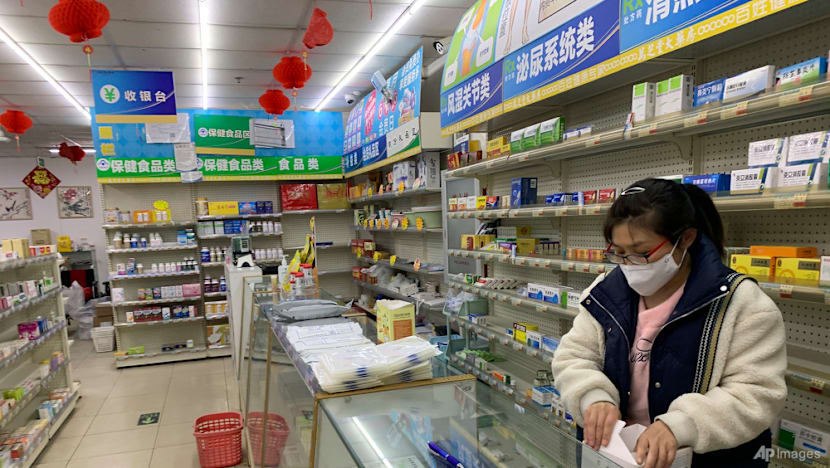Commentary: China’s drugmakers have more to fear from Washington
They may be spared by US tariffs on pharmaceuticals, but longer-term risks remain, says Juliana Liu for Bloomberg Opinion.

HONG KONG: Because of the way Chinese pharmaceutical companies do business with the United States, they’re largely exempt from US President Donald Trump’s recently announced 100 per cent levy on patented drugs.
It’s too soon to breathe easy. A slew of regulatory risks from Washington persists for an industry that simultaneously enjoys a deeply interdependent relationship with its American partners while also being seen as an existential threat.
In January, DeepSeek surprised the world by introducing a low cost, effective open-source language model. Two months later, electric vehicle maker BYD unveiled a five-minute charging system, only to be seemingly outdone by rival battery supplier Contemporary Amperex Technology in April.
This level of innovation isn’t confined to the tech industry. It has been happening for longer and with less fanfare in the biotech space. Last September, China’s drugmakers had their own DeepSeek moment. That’s when a local upstart outdid in a clinical trial the world’s best-selling medication, a widely used cancer drug called Keytruda from Merck.
Patients using the new treatment, called ivonescimab, went for more than 11 months before their tumors began to grow again, compared with just under six months for Keytruda, which is expected to bring in sales of US$30 billion this year.
Shares in Miami-based Summit Therapeutics – which had licensed the drug from Chinese firm Akeso to be commercialised in the US, Canada, Europe and Japan – soared, even as the therapy still needs to be approved by American regulators.
EXPERIMENTAL THERAPIES, MULTIBILLION-DOLLAR DEALS
The development was seen as a milestone for an industry that has been taking steady steps toward disruption. Before China began opening up its economy in the late 1970s, nearly all of its pharmaceutical companies were state run. For decades afterward, most stuck to copycat “me-too” drugs.
That’s changing fast. Starting two decades ago, the government began to make it more attractive for returning scientists, like Akeso CEO Michelle Xia, a cancer researcher, to set up shop after long careers overseas. And in 2015, Beijing threw its full weight behind the Made in China 2025 industrial policy, having identified 10 key areas – including pharmaceuticals – in which it aimed to go head-to-head with Western companies.
That effort has been largely successful. Chinese drugmakers have begun rolling out experimental therapies and inking multibillion-dollar licensing agreements to take the products worldwide.
From 2021 to 2024, those deals nearly quadrupled. They hit a record in just the first six months of this year, with US-bound ones accounting for more than half of the total value, according to Rebecca Liang, senior China biopharma analyst at Bernstein.
It’s a logical arrangement. Homegrown pharmaceutical firms have the medicines and muscle, but they’re likely to encounter regulatory hurdles in developed markets if they go out to commercialise it all themselves. By Big Pharma standards, their prices are reasonable. According to Cui Cui, an analyst at Jefferies, the Chinese side usually gets a 10 per cent to 15 per cent cut of revenues outside its home market.
As for the established global players, they’re on the prowl for new, tested and cost-effective therapies. With blockbuster drugs generally losing patent protection after 20 years, firms risk hundreds of billions in lost revenue over the next decade if they fail to get new medicines into their development pipelines.
RISK OF SHUTTING OUT CHINESE DRUGMAKERS
The symbiotic relationship between Chinese and US biotech companies wasn’t targeted by last week’s tariffs, which addressed only branded medicines and not the way they were developed.
This could still change. It’s unclear whether the administration plans to release further findings of its probe into the national security implications of pharmaceutical imports, which could potentially pave the way for even more levies or other restrictions.
Earlier this month, the New York Times reported the Trump administration had drafted an executive order that could eventually target medical treatments of Chinese origin. Such transactions may have to undergo mandatory review by the Committee on Foreign Investment, a panel that scrutinises proposals by foreign entities to buy US assets, in the future.
Investors and executives, including the president’s son-in-law Jared Kushner, were reportedly concerned about their investments in American biotech firms that were falling behind.
The White House was quoted as saying it was not “actively considering” the order. Indeed, major pharmaceutical firms such as Pfizer and AstraZeneca were reportedly lobbying hard against the move because of China’s entrenched position in their supply chains.
But from EVs to batteries to mobile phones, Washington has a track record of closing the US market to Chinese challengers, often citing national security reasons.
As a result, rising regulatory scrutiny of experimental treatments from China is a risk that cannot be ignored. That could threaten a well-established way for American patients to access many innovative drug candidates at a time such treatments are in enormous demand.















